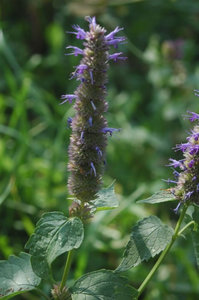
Pinyin: Huo-xiang Latin: Agastache Rugosa
Physical Characteristics:
Agastache Rugosa is a perennial growing to 1m by 0.6m hardy to zone 8 and not frost tender. Agastache Rugosa is in flower from July to September, and the seeds ripen in September. The flowers are hermaphrodite (have both male and female organs) and are pollinated by Bees. The plant is self-fertile. Agastache Rugosa is noted for attracting wildlife.
The plant prefers light (sandy) and medium (loamy) soils and requires well-drained acid, neutral and basic (alkaline) soil. Agastache cannot grow in the shade and requires dry or moist soil.
Family:
Edible Uses:*
Edible Parts: Leaves; Seed. Edible Uses: Condiment; Tea.*
Young Agastache leaves may be used raw or cooked[177] giving a strong anise-like fragrance. The leaves are normally used as a flavouring[183] or as an addition to the salad bowl[238]. We find them a bit coarse and too strong for use as a salad[K]. The leaves can be used as a tea substitute[183]. A pleasant flavour[238]. The seed is possibly edible[177]. No further details. The Agastache seed certainly should not be poisonous, but is very small and would be very fiddly[K].*
Traditional Chinese Medicinal (TCM) Uses:*
Korean mint is commonly used in Chinese herbalism, where it is considered to be one of the 50 fundamental herbs[218].*
Considered to be a "warming" herb, Agastache is used in situations where there is "dampness" within the digestive system, resulting in poor digestion and reduced vitality[254]. The leaves and stems are antibacterial, antifungal, aromatic, carminative, diaphoretic, febrifuge and stomachic[147, 176, 218, 238, 279].*
Agastache Rugosa leaves are used internally to improve the appetite and strengthen the digestive system[238], relieve symptoms such as abdominal bloating, indigestion, nausea and vomiting[254]. They are also used to treat morning sickness[254]. The leaves are also used in the treatment of chest congestion, diarrhoea and headaches[218]. An infusion of Korean Mint leaves is used in the treatment of angina pains[222]. The plant is used as a folk remedy for cancer, extracts of the plant have shown anticancer activity[218].*
References:
- [K] Ken Fern [58] Ohwi. G.Flora of Japan. (English translation) Smithsonian Institution 1965
- [111] Sanders. T. W.Popular Hardy Perennials. Collingridge 1926
- [133] Rice. G. (Editor)Growing from Seed. Volume 1. Thompson and Morgan. 1987
- [147] A Barefoot Doctors Manual. Running Press 0 ISBN 0-914294-92-X [176] Yeung. Him-Che.Handbook of Chinese Herbs and Formulas. Institute of Chinese Medicine, Los Angeles 1985
- [177] Kunkel. G.Plants for Human Consumption. Koeltz Scientific Books 1984 ISBN 3874292169
- [183] Facciola. S.Cornucopia - A Source Book of Edible Plants. Kampong Publications 1990 ISBN 0-9628087-0-9
- [200] Huxley. A.The New RHS Dictionary of Gardening. 1992. MacMillan Press 1992 ISBN 0-333-47494-5
- [218] Duke. J. A. and Ayensu. E. S.Medicinal Plants of China Reference Publications, Inc. 1985 ISBN 0-917256-20-4
- [222] Foster. S. & Duke. J. A.A Field Guide to Medicinal Plants. Eastern and Central N. America. Houghton Mifflin Co. 1990 ISBN 0395467225
- [238] Bown. D.Encyclopaedia of Herbs and their Uses. Dorling Kindersley, London. 1995 ISBN 0-7513-020-31
- [244] Phillips. R. & Foy. N.Herbs Pan Books Ltd. London. 1990 ISBN 0-330-30725-8
- [254] Chevallier. A.The Encyclopedia of Medicinal Plants Dorling Kindersley. London 1996 ISBN 9-780751-303148
- [275] Flora of Japan
- [279] Medicinal Plants in the Republic of Korea World Health Organisation, Manila 1998 ISBN 92 9061 120 0
Source: Agastache Rugosa Plants For A Future, England 1996-2008.
This work is licensed under a Creative Commons License.
Natural dietary supplements are designed to offer the body support to promote health, harmony, balance and overall well being.*

 Get Well Natural, LLC
Get Well Natural, LLC  Kidney Function & Regeneration Health
Kidney Function & Regeneration Health  Platelet & Blood Cell Health
Platelet & Blood Cell Health  Prostate, Flow & Function Health
Prostate, Flow & Function Health  General Mind & Body Health
General Mind & Body Health  Heart, Cholesterol & Cardio Health
Heart, Cholesterol & Cardio Health  Allergy-Free Body
Allergy-Free Body  Anxiety & Stress
Anxiety & Stress  Blood Platelet Counts & Function
Blood Platelet Counts & Function  Blood Pressure Health
Blood Pressure Health  Kidney Function Health
Kidney Function Health  Immune System Health & Balance
Immune System Health & Balance  Prostate & Urinary Health Function
Prostate & Urinary Health Function  Blood Sugar Balance
Blood Sugar Balance  Cardiovascular Heart Health
Cardiovascular Heart Health  Detoxification & Healthy Cells
Detoxification & Healthy Cells  Women's Health
Women's Health  Liver Regeneration
Liver Regeneration  Pain-Free Body
Pain-Free Body  Water & Air Filtration
Water & Air Filtration 


